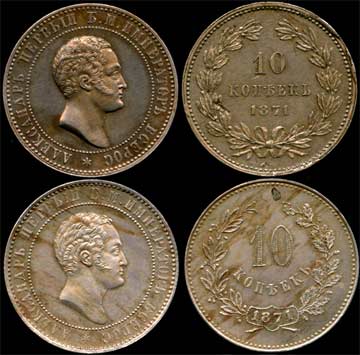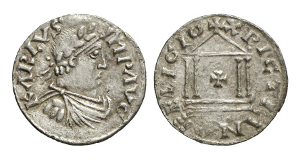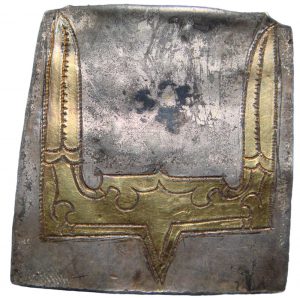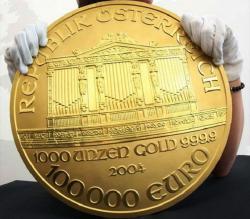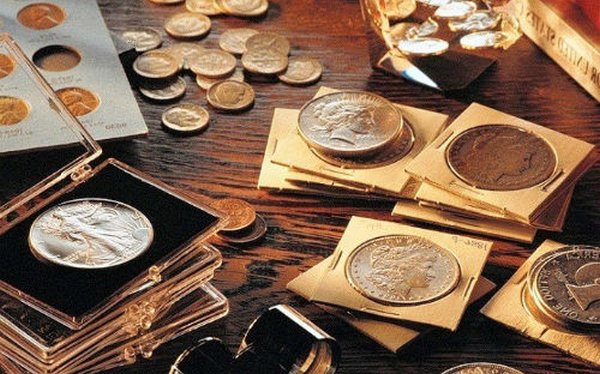Roman coins (III century BC – V century AD)
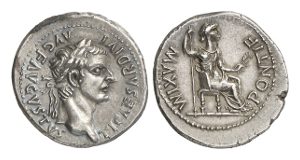 The Roman Empire dominated most of the ancient world known to us for over 500 years and exerted a decisive influence on the economy, art and culture of Europe in subsequent centuries. In the area of coin minting and in money making in general, the Romans also laid the foundations for their subsequent development.
The Roman Empire dominated most of the ancient world known to us for over 500 years and exerted a decisive influence on the economy, art and culture of Europe in subsequent centuries. In the area of coin minting and in money making in general, the Romans also laid the foundations for their subsequent development.
The most ancient Roman coins were cast in bronze (the so-called “heavy bronze”, Aes grave), and the image on them contained an indication of dignity in assa (the ass was equal to one pound) and ounces (1/12 assa). For example, one quadrant with three points was equal to 3 ounces or 1/4 of an ass. However, in practice such coins turned out to be very inconvenient. The main Roman silver coin Denarius was introduced into circulation in 211 BC. and had a cost of 10 (later at 16) assov. First, on this Roman coin, on the obverse, the head of the goddess Roma was depicted in a helmet, and on the reverse – the Dioscuri Castor and Polidevk on horseback and the inscription “ROMA”.
During the II century BC. The persons responsible for the issue (Tresviri monetales, coin masters) received the right to place their name on the imprint of the Roman coins and decide on the coin image themselves. Often they chose the valiant deeds of their own ancestors as motives for the image. Such “family coins”, containing many mythological and historical images, are an exciting and multifaceted collection area, first of all, if you come across coins with such famous names as “SVLLA” or “BRVTVS”. Guy Julius Caesar was the first Roman, whose Senate in 44 BC. endowed the right to mint his portrait on Roman coins during his lifetime. He actively used this right. After the murder of Caesar, portraits of his allies and opponents – Pompey, Brutus and Antony appear on Roman coins.
With the fall of the republic and the establishment of the empire on coins, the portraits of the current emperors and their family members (wives, heirs to the throne and co-rulers) were minted. In the monetary business, three types of metal are still used – gold, silver and bronze. The coin legend is expanding: the titles and titles of the emperor and the indication of the year are added, therefore, it is not difficult to determine the year of issue of the coin. For example, “COS V” means that the coin was minted during the fifth consulate; the figure meant how many times the position was filled.
In ancient Rome, there were many different types and denominations of coins and mints, which are described in detail in easily accessible special literature. Thanks to this, many interesting collectible areas are open to beginner collectors of Roman coins. In addition, for collectors will be important the fact that the coins of the Roman Empire was not only a means of payment, but also played the role of the media. They were a kind of “metal newspapers” of the empire, which forever captured the deeds and military successes of the emperors.
At the end of the era of the Roman Empire, the cost and percentage of the precious metal in Roman coins declined more and more. The emperors Diocletian (284-304) and Constantine the Great (308-337) tried to resist this with the help of monetary reforms and the establishment of new denominations, for example, a bronze follis or gold solid. However, in the end, neither the fall of the currency nor the fall of the empire could be prevented. Romulus Augustus (475-476) was the last emperor of the Western Roman Empire, whose portrait was imprinted on Roman coins. The portrait on the minted coins after that belonged to the German officer Odoakr.
Immerse yourself in the exciting times of the Punic Wars, the conquest of Gaul by Caesar or the great fire in Rome under the emperor Nero, touch Roman antiquity in a coin image! Collecting Roman coins, you collect not only coins, but also events of the past.
